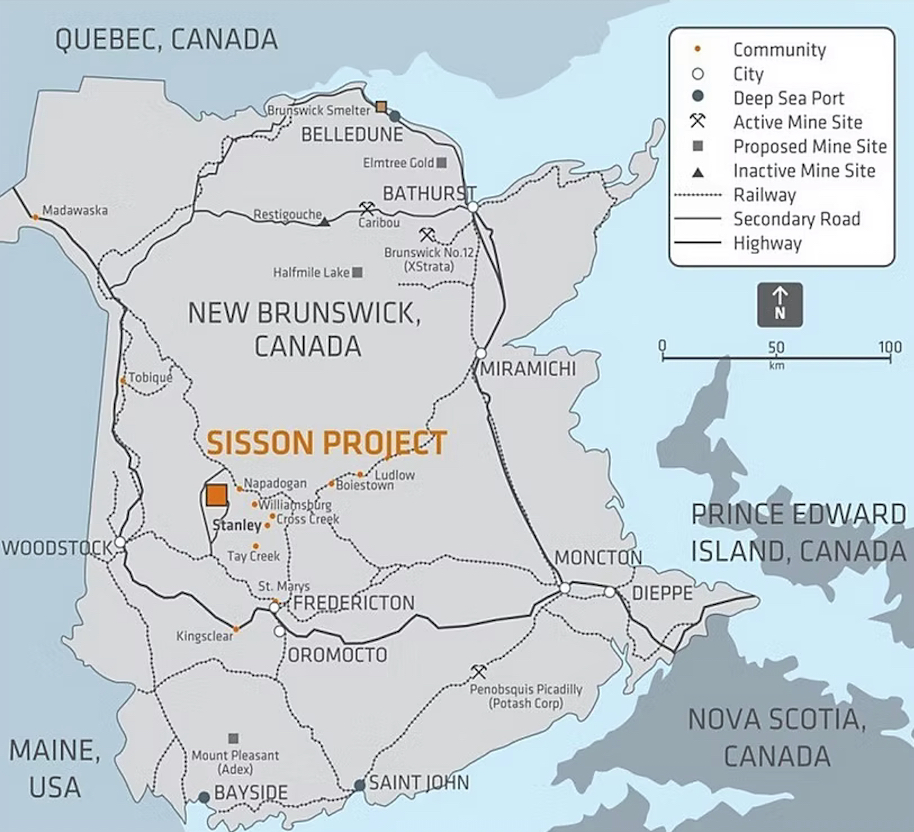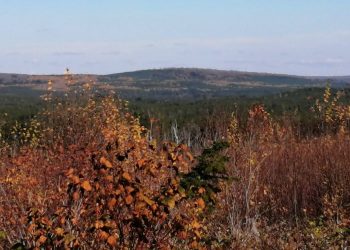The Department of Natural Resources has released a 20-page report meant to serve as a framework for a “comprehensive minerals strategy” in New Brunswick.
The document was released Monday morning during a mining and petroleum industry conference in Fredericton.
New Brunswick’s Liberal government has touted the mining sector as an engine of economic development, notably the proposed Sisson mine.
But Indigenous land defenders have vowed to resist the proposed tungsten and molybdenum mine, which has received financial support from the U.S. Department of Defence.
The Wolastoqey Grand Council has insisted that free, prior and informed consent is required for the project to proceed, citing the UN Declaration on the Rights of Indigenous Peoples.
The new minerals framework document doesn’t reference UNDRIP.
Asked whether the declaration’s principles have been integrated into the framework, Minister of Natural Resources John Herron didn’t answer directly but said the document “isn’t totally developed.”
Reconciliation a ‘guiding principle’
Herron presented the framework during New Brunswick’s 50th annual Exploration, Mining and Petroleum Conference.
In a speech, he said that “reconciliation through authentic partnerships with First Nations” is among the “guiding principles” of the process.
He said that “extensive engagement across First Nations” had taken place so far as the multinational firm PricewaterhouseCoopers worked on the document with an Indigenous consulting firm.
On the matter of consultation with First Nations, Herron repeated several times that there is “more to come.”
A first draft of the report is due in early January next year, followed by a final report in the springtime.
Herron said the “full, comprehensive minerals strategy” will be released at PDAC 2026 — a massive industry convention taking place in Toronto in the first week of March.
Legislation linked to the strategy will also be tabled next year, according to the throne speech delivered last week.

Sisson mine
Environmental approvals for the Sisson project, which would create an open-pit mine in the Upper Nashwaak River area, require that construction begins by the end of this year.
Northcliff Resources — the company behind the project — has requested an extension from the province.
In 2017, Woodstock First Nation signed a “cooperation agreement” with the company, and all six Wolastoqey communities signed revenue-sharing agreements with the province.
However, five Wolastoqey chiefs later reportedly stated that they oppose the project and felt coerced by the Liberal government of the day into signing the agreement.
On Monday, Northcliff Resources chairman and CEO Andrew Ing told conference-goers that “we continue to engage” with First Nations.
He said the company is currently talking to potential buyers for minerals that would be extracted from the mine and trying to secure financing for its construction.
This year, the company launched a renewed feasibility study for the project with $20.7 million from the Pentagon and $8.2 million in “conditional funding” from Government of Canada.
Duty to consult, accommodate
Wolastoq Elders have opposed the mine in the name of protecting unceded Indigenous land and water.
The greatest concern for many who oppose the Sisson project is the possibility that its massive tailings dam will breach.

The NB Media Co-op asked Herron if he had any message for the Wolastoqey Grand Council and Indigenous land defenders who oppose the project.
“We’ve had a number of conversations now already,” Herron said. “I’m happy to meet with the Grand Chief [Ron Tremblay] at any time.”
“This government understands that we have a duty to consult [and] a duty to accommodate,” Herron continued.
But he suggested that the government is only required to go through that process with recognized First Nation chiefs, as opposed to the Grand Chief, who represents a traditional governance structure with a grassroots constituency.
That legal theory may rely on a 2019 ruling, in which a New Brunswick judge dismissed complaints from the Wolastoqey Grand Council about a snowmobile hub project at Mount Carleton, saying the traditional council had no legal standing for consultation.
“Regardless of [whether] it’s constitutionally necessary or not, we want this relationship to be right,” Herron said.
Sales pitch to investors
The report itself outlines a vision for an “an investor-ready framework that secures social license while unlocking the province’s full mineral potential.”
Much of the framework resembles a sales pitch to industry. It notes that geoscientific data are “freely accessible to industry through a variety of databases, and Geological Survey staff are available for consultation to support industry efforts.”
The report acknowledges that mining activity has declined in recent years but points to the presence of various so-called critical minerals, such as the “recently recognized lithium occurrences in southern New Brunswick.”
The Woodstock area also has “the largest undeveloped resources of manganese in North America,” the report states, making it “a significant opportunity to supply the battery industry.”
It also points to discoveries such as gold near the Bathurst mining camp — although gold isn’t listed as one of Canada’s critical mineral and activists consider it to be among the most destructive forms of mining.
The report touts “strategic infrastructure advantages” in New Brunswick, such as its two deepwater ports.
It also cites a 2011 survey of mining companies conducted by the right-wing Fraser Institute, which gave New Brunswick the highest rank out of 93 jurisdictions around the world for “overall policy attractiveness.”
Government officials and industry have called for faster development of natural resources in response to the trade war launched by U.S. President Donald Trump.
They have also cited competition with China, which has restricted exports of critical minerals in response to the American trade war.
Strategic priorities
Five “strategic priorities” are outlined in the document:
- “shortening and streamlining” processes required for permits and regulatory approval
- “promoting awareness” about mining in New Brunswick among investors and the general public
- the development of “meaningful Indigenous partnerships”
- improvements to the “investment environment”
- “planning for local benefits.”
-With files from Dora Szemok
David Gordon Koch is a journalist with the NB Media Co-op. This reporting has been made possible in part by the Government of Canada, via the Local Journalism Initiative.




![Mi’kmaq senator pushing for end to ‘second-generation cut-off’ gains traction, but feds signal opposition [video]](https://nbmediacoop.org/wp-content/uploads/2025/11/S2Nov132205-2-350x250.jpg)
![Interview with Anita Joseph, winner of the New Brunswick Human Rights award [video]](https://nbmediacoop.org/wp-content/uploads/2025/11/AnitaJoseph-2-350x250.jpg)



![Mi’kmaq senator pushing for end to ‘second-generation cut-off’ gains traction, but feds signal opposition [video]](https://nbmediacoop.org/wp-content/uploads/2025/11/S2Nov132205-2-120x86.jpg)
